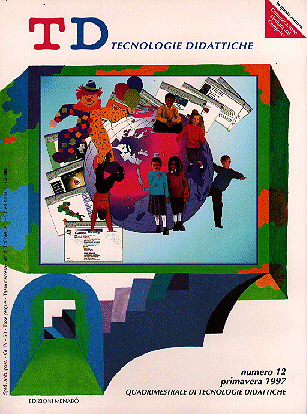Il computer a supporto dell'educazione musicale
Contenuto principale dell'articolo
Abstract
Dettagli dell'articolo
Gli autori che pubblicano su questa rivista accettano le seguenti condizioni:
- Gli autori mantengono i diritti sulla loro opera e cedono alla rivista il diritto di prima pubblicazione dell'opera, contemporaneamente licenziata sotto una Licenza Creative Commons CC BY 4.0 Attribution 4.0 International License.
- Gli autori possono aderire ad altri accordi di licenza non esclusiva per la distribuzione della versione dell'opera pubblicata (es. depositarla in un archivio istituzionale o pubblicarla in una monografia), a patto di indicare che la prima pubblicazione è avvenuta su questa rivista.
- Gli autori possono diffondere la loro opera online (es. in repository istituzionali o nel loro sito web) prima e durante il processo di submission, poiché può portare a scambi produttivi e aumentare le citazioni dell'opera pubblicata (Vedi The effect of Open Access).
Riferimenti bibliografici
Angelides M. C. (1994). Implementing multiple tutoring strategies in an intelligent tutoring system for music learning. Journal of Information Technology, 10 (1), 52-62.
Biasutti M. (1990). Estetica, analisi e psicologia dei processi artistici contemporanei. Attualità in Psicologia, 6 (1), 23-33.
Chen S. S., Dennis J. R. (1993). Linking different cultures by computers: a study of computer-assisted music notation instruction. Journal of Educational Technology Systems, 21 (3), 207-224.
Forsythe, R. (1984). The development and implementation of a computerized preschool measure of music audiation (aptitude, ability, testing). Unpublished doctoral dissertation, Case western reserve University, Cleveland.
Herrold R. M. (1977). The development and trial of a computer managed test of music fundamentals. Oregon Council for Research in Teacher Education. Eric.
Higgins W. (1992). Technology. In R. Colwell (Ed.), Handbook of research on music teaching and learning. (pp. 480497). New York: Mc-millan.
Hofstetter F. T. (1978). Computer-based recognition of perceptual patterns in harmonic dictation exercises. Journal of Research in Music Education, 26(2), 111-119.
Hofstetter F. T. (1979). Evaluation of a competency-based approach to teaching aural interval identification. Journal of Research in Music Education, 27(4), 201-213.
Hofstetter F. T. (1981). Applications of the GUIDO system to aural skills research, 1975-1980. College Music Symposium, 21, 46-53.
Hughes T. (1994). A hypermedia listening station for the college music literature class. Research Studies in Music Education, 3, 3-14.
Lamb M. R., Bates, R. H. T. (1978). Computerized aural training: An interactive system designated to help both teachers and students. Journal of computer-based instruction, 5(1-2), 30-37.
MacGregor R. (1994). Music notational software based on children’s own symbolic representations of sound. Research Studies in Music Education, 3, 15-24.
McCarthy J. (1984). The pitch test. Creative computing, 3, 211-217.
Pembrook R. G. (1986). Some inplications of students’ attitudes toward a computer-based melodic dictation program. Journal of Research in Music Education, 34(2), 121-133.
Peters G. D. (1978). Percussion instruction methods by computer. The Instrumentalist, 32(6), 41-43.
Radocy R. E. (1971). Development of a computerized criterion-referenced test for certain nonperformance musical behaviors requisite to teaching music. Unpublished doctoral dissertation, Pennsylvania State University, University Park.
Robinson R. L. (1988). Drake musical aptitude test (computer program). Bellevue: Temporal acuity products.
Schaeffer P. (1966). Traité des objets musicaux. Parigi: Edition du Seuil.
Stech D. A. (1994). The MIDI sequencer/ sound module as critical listening device. Research Studies in Music Education, 3, 36-43.
Upitis R. (1989). The craft of composition: Helping children to create music with computer tools. Psychomusicology, 8(2), 151-163.
Webster P. (1989). Composition software and issues surroundings its use in research settings with children. Psychomusicology, 8(2), 163-169.
Weidenbach V. (1994). Technology teaching the teacher: a study of keyboard instructional praxis in a computer-based learning environment. Research Studies in Music Education, 3, 44-53.

